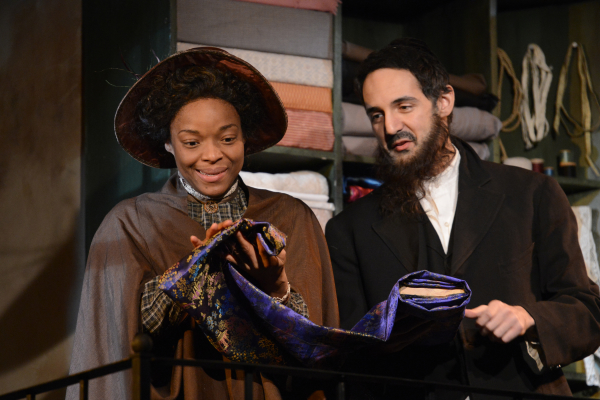Intimate Apparel

(© Glenn Perry)
Lynn Nottage's play Intimate Apparel is a tribute to the sisterhood of female artists who found independence by plying their skills with a needle and a sewing machine. Set at the turn of the 20th century, Nottage presents the story of an African-American woman named Esther who escaped the South at age 17 and made her way alone to New York to earn her living by creating beautiful undergarments for women from all strata of society. The story Nottage tells, presented by Lyric Stage Company, runs parallel to the histories related in Isabel Wilkerson's masterful book The Warmth of Other Suns, which details forgotten odysseys of people of color, stories important to understanding our national heritage.
Intimate Apparel weaves together the lives of Esther; her landlady, Mrs. Dickson; her upper-class client, Mrs. Van Buren; and Mayme, a gifted ragtime pianist and composer who makes her living as a prostitute, at one dollar a night. These women have different takes on the divide between love and marriage. Esther (Lindsey McWhorter), who is 35, longs to be touched but believes that she is too plain to attract a man. Mrs. Dickson speaks from experience about the disappointments of trusting a man. Mrs. Van Buren (Amanda Ruggiero), dripping with diamonds and a cynical lilt to her voice, has been spurned by her husband for not producing an heir while Mayme (Kris Sidberry) has divorced love from physical contact and shows passion only for the piano in her room.
The two men in the cast have different natures, races, and classes, but they share the desire for a life with someone to love. George Armstrong (Brandon G. Green) is a laborer working in the hell of building the Panama Canal, where "a black man dies for every 20 feet" of digging. Mr. Marks (Nael Nacer) is an unmarried, observant Orthodox Jew who runs the fabric shop where Esther buys her goods. Mrs. Van Buren and Mr. Marks are white, the other characters are black, enforcing the chasm between the opportunities open to each of them.
The play hinges on George's letters sent from Panama. Given Esther's name by one of his fellow workers who knew her from church, George woos Esther with his eloquent prose. Their long-distance correspondence builds to a courtship and later, a marriage proposal. After Esther accepts him, George comes to New York where they are married. The second act of the play follows their "happily ever after" — when the couple begins to learn each other's secrets and discover that things aren't always as they seem on paper. But if the relationships between the men and women are unfulfilling, the strength of the women's friendships and their support for each other are not.
Under the direction of Summer L. Williams, who carefully skirts the melodrama of the plot and the sometimes clichéd characters, the ensemble of actors delivers appropriately nuanced portraits. McWhorter is a strong protagonist as Esther, except when she comes off as too adolescent and giggly for a 35-year-old woman. However, she makes us believe Esther's calm acceptance of disappointment and her strength to carry on as the play unfolds. Ruggiero's Mrs. Van Buren is a study in subterfuge, only opening up to the sympathetic but pragmatic Esther; Mayme turns the prostitute with a warm heart for Esther into a lively image of a fallen woman with an unrecognized talent for music. Nacer breaks through the stereotypical trappings of his Mr. Marks to allow his feelings to show. Green plays the stud George Armstrong as an appealing villain.
The set and props, designed by Anne Sherer, support the impact of Nottage's work as much as the dialogue. A Singer sewing machine, a quilt of patches representing Esther's life, and the upright piano add further impact to the pair of sepia-edged photographs projected on the back wall that are labeled as "unidentified black couple, c. 1905," and "unidentified black seamstress." Amanda Mujica's costumes also lend a sense of the period plus a decorative touch in the elegant, bead-encrusted corsets that Esther sews for her customers.
Esther's world, brought to life with a strong ensemble and spot-on production values, is a reminder of the ordinary people who represent a forgotten part of our history. The playwright has not only done us a service in retelling their stories but provided a poignant theatrical event.










